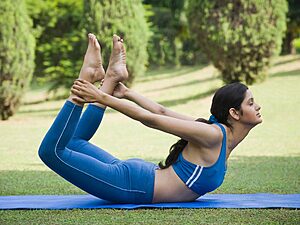The benefits of holding a yoga pose for some minutes are strength, stability, focus and endurance. The practice of yoga can help to calm the mind and create a more toned body. Regularly holding a yoga pose for an extended period of time will help improve overall fitness levels as well as reduce the likelihood of injury.
In this post, you will learn practical tips that will help you hold your yoga pose for a few more minutes.
How do breath and focus help in holding a yoga pose?
Step 1: Understand the type of yoga you are practicing
The type of yoga one practices has a direct relation to breath and focus when holding a yoga pose. Understanding the breath control techniques that are related to the type of yoga can help practitioners achieve peak performance in their practice. The use of alternate nostril breathing or three part breath is especially beneficial for yin or restorative poses.
Step 2: Know the length of time to hold each pose
In order to maximize the benefits of a yoga practice, each pose should be held for a varying amount of time, depending on the style and goals of the individual. Generally, poses should be held for between a few seconds and five minutes. It is important to listen closely to one’s body and stop if there is discomfort or fatigue.
Step 3: Set a timer and focus on your breathing
Focusing on the breath while in a yoga pose helps to clear the mind and keep it balanced. By using breathing techniques such as Alternate Nostril Breathing or Cooling Breath, practitioners can expand their lungs and create an even rhythm of breath to stay calm and relaxed throughout their practice. The Three Part Breath technique is also beneficial in practicing yin or restorative yoga, as it involves deep inhales and exhales through the nose, filling up both chest and abdomen with air before holding for 5-10 seconds. Practicing Kapalbhati/Breath of Fire can also help to warm up muscles before attempting a longer pose; by making sure that inhales and exhales are equal in force, depth, and time, practitioners will find that they have more stamina when attempting poses for 4-5 minutes.
Step 4: Focus on the alignment of your body
Focusing on breath and alignment is key to holding a yoga pose for 4 to 5 minutes. Proper alignment and breath control help practitioners align their bodies correctly in each pose, allowing them to achieve the desired pose while calming their mind. This can also reduce stress, improve concentration, increase flexibility, and provide beneficial physical and mental benefits.
Step 5: Allow yourself to feel the sensations of each pose
Breath and focus help in holding a yoga pose by allowing the practitioner to stay aware of their mind and alignment, while maintaining an attitude of acceptance and patience towards uncomfortable feelings. Focusing on the breath can help keep the mind clear, while observing any emotions without attaching to them allows for greater control over how long one can hold a pose.
Step 6: Embrace the challenge of each pose
Embracing the challenge of each pose can help with focus and breath control by increasing strength, power and discipline. Practicing acceptance of the discomfort caused by holding poses for a long time can assist in mastering difficult poses, such as Warrior. By focusing on the breath and feelings without attaching to them, practitioners can learn to better manage their emotions when faced with challenging positions.
Step 7: Be aware of the effects of the pose on your body and energy levels
The importance of being aware of the effects of a yoga pose on the body and energy levels is paramount for any practitioner, as it helps them understand how their practice impacts their physical and mental wellbeing. A mindful approach to yoga can help practitioners gain greater clarity into how each pose affects them, enabling them to adjust their practice accordingly.
Step 8: Incorporate meditation and visualization in your practice
Meditation and visualization can help a person hold a yoga pose for longer periods by challenging the mind and cultivating stability.
Step 9: Listen to your body and adjust your practice accordingly
Listening to one’s body can be essential in improving the practice of yoga. By paying attention to bodily sensations and signals, individuals can ensure that they are properly aligned while performing their poses.
Step 10: Take time to rest and relax in between poses
Resting between yoga poses is important in order to allow the body time to relax and recover. This helps ensure that the benefits of each pose can be achieved quickly and efficiently, as holding poses for a short period of time without breaks is ideal.

What are some tips on how to improve your stamina while performing a long-held posture?
- Take shorter breaths while holding the posture
- Increase the duration of the posture gradually.
- Focus on proper alignment
- Strengthen your core and other muscle groups
- Perform dynamic movements in between poses
- Use props to support yourself
- Incorporate stretching and relaxation
- Use affirmations to stay motivated
- Visualize your success
- Listen to calming music
What should you consider when picking out poses that require longer holds?
- Consider your skill level
- Understand the type of pose you are attempting
- Listen to your body
- Use props if necessary
- Take breaks when needed
- Set a goal for how long to hold the pose
- Consider the pose’s benefits
- Focus on your breathing
- Practice regularly
- Start with poses that require shorter holds
- Warm up before each session
- Choose a comfortable environment
- Pay attention to your alignment
- Focus on your posture
- Try different poses
- Increase the duration of the poses gradually
- Take rest days
- Stay hydrated
- Monitor your heart rate
- Consider your diet
Conclusion
Maintaining your pose for a few minutes longer goes a long way to improve your yoga practice. Keep in mind that you should also listen to your body. If it feels too stressed when you hold longer poses, try to cut it down.


